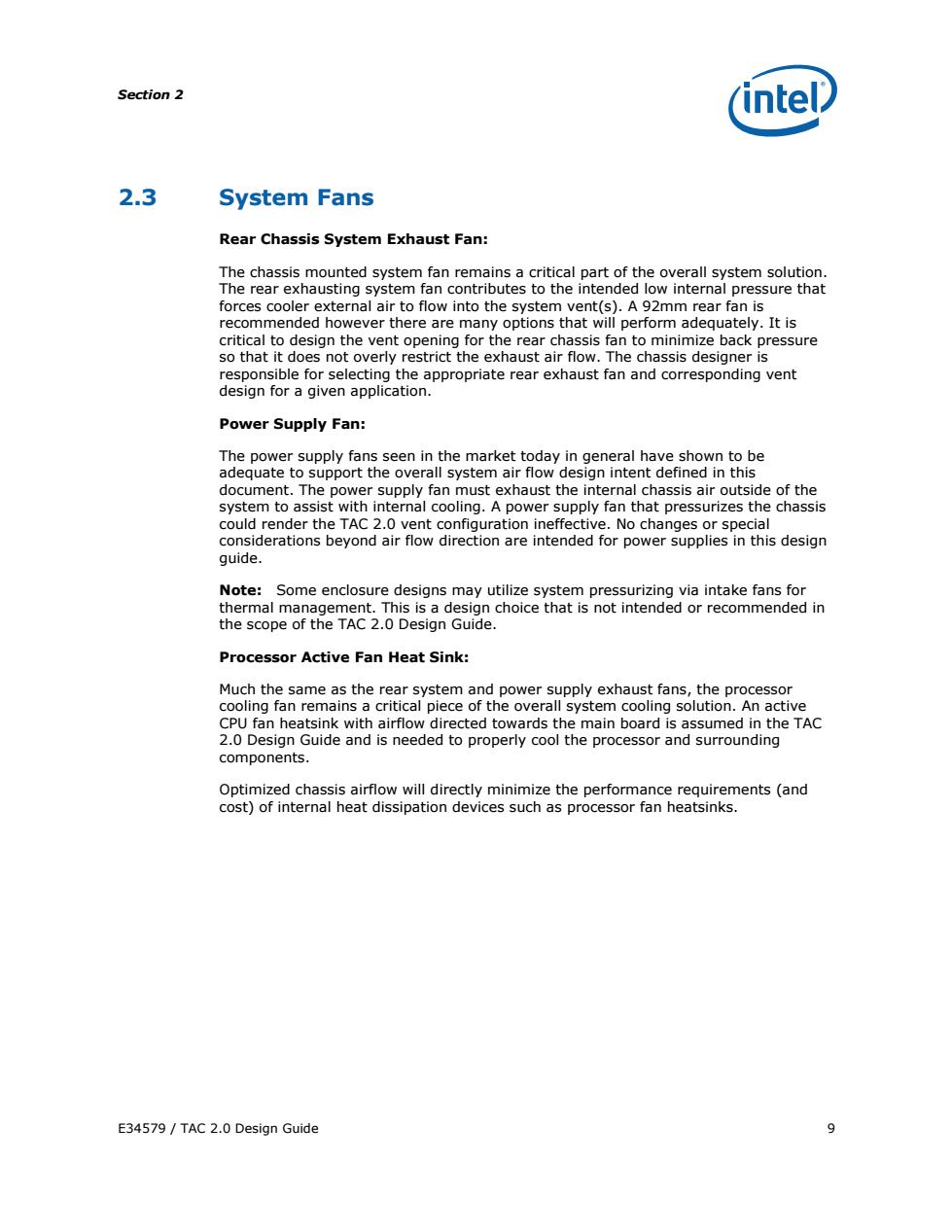正在加载图片...

Section 2 intel) 2.3 System Fans Rear Chassis System Exhaust Fan: The chassis mounted system fan remains a critical part of the overall system solution. The rear exhausting system fan contributes to the intended low internal pressure that forces cooler external air to flow into the system vent(s).A 92mm rear fan is recommended however there are many options that will perform adequately.It is critical to design the vent opening for the rear chassis fan to minimize back pressure so that it does not overly restrict the exhaust air flow.The chassis designer is responsible for selecting the appropriate rear exhaust fan and corresponding vent design for a given application. Power Supply Fan: The power supply fans seen in the market today in general have shown to be adequate to support the overall system air flow design intent defined in this document.The power supply fan must exhaust the internal chassis air outside of the system to assist with internal cooling.A power supply fan that pressurizes the chassis could render the TAC 2.0 vent configuration ineffective.No changes or special considerations beyond air flow direction are intended for power supplies in this design guide. Note:Some enclosure designs may utilize system pressurizing via intake fans for thermal management.This is a design choice that is not intended or recommended in the scope of the TAC 2.0 Design Guide. Processor Active Fan Heat Sink: Much the same as the rear system and power supply exhaust fans,the processor cooling fan remains a critical piece of the overall system cooling solution.An active CPU fan heatsink with airflow directed towards the main board is assumed in the TAC 2.0 Design Guide and is needed to properly cool the processor and surrounding components Optimized chassis airflow will directly minimize the performance requirements (and cost)of internal heat dissipation devices such as processor fan heatsinks. E34579/TAC 2.0 Design Guide 9Section 2 E34579 / TAC 2.0 Design Guide 9 2.3 System Fans Rear Chassis System Exhaust Fan: The chassis mounted system fan remains a critical part of the overall system solution. The rear exhausting system fan contributes to the intended low internal pressure that forces cooler external air to flow into the system vent(s). A 92mm rear fan is recommended however there are many options that will perform adequately. It is critical to design the vent opening for the rear chassis fan to minimize back pressure so that it does not overly restrict the exhaust air flow. The chassis designer is responsible for selecting the appropriate rear exhaust fan and corresponding vent design for a given application. Power Supply Fan: The power supply fans seen in the market today in general have shown to be adequate to support the overall system air flow design intent defined in this document. The power supply fan must exhaust the internal chassis air outside of the system to assist with internal cooling. A power supply fan that pressurizes the chassis could render the TAC 2.0 vent configuration ineffective. No changes or special considerations beyond air flow direction are intended for power supplies in this design guide. Note: Some enclosure designs may utilize system pressurizing via intake fans for thermal management. This is a design choice that is not intended or recommended in the scope of the TAC 2.0 Design Guide. Processor Active Fan Heat Sink: Much the same as the rear system and power supply exhaust fans, the processor cooling fan remains a critical piece of the overall system cooling solution. An active CPU fan heatsink with airflow directed towards the main board is assumed in the TAC 2.0 Design Guide and is needed to properly cool the processor and surrounding components. Optimized chassis airflow will directly minimize the performance requirements (and cost) of internal heat dissipation devices such as processor fan heatsinks